 Last additions - Geisha & Women Postcards Last additions - Geisha & Women Postcards |

Tres Flores. Intriguing pose. It looks like a modern postcard, but it's postmarked 1907!Sep 19, 2008
|
|

Typical woman and flower. Give a woman a flower and ask her to pose with it, and this is how she typically would hold it.Sep 19, 2008
|
|

Woman and cherry blossoms. Unfortunately, she's too hunchbacked in this picture.Sep 19, 2008
|
|

Sep 19, 2008
|
|

Teruha with chrysanthemum. The flower she's holding matches her kimono design that shows the same flower. Her name was Teruha and she appeared in many postcards. She was born in 1896 in Osaka and worked as a geisha in Shimbashi, Tokyo. Click to read mTeruha with chrysanthemum. The flower she's holding matches her kimono design that shows the same flower. Her name was Teruha and she appeared in many postcards. She was born in 1896 in Osaka and worked as a geisha in Shimbashi, Tokyo before becoming a Buddhist priest in Kyoto. Read more about her interesting life by James A. Gatlin at geikogallery.com.Sep 19, 2008
|
|

Woman with two flowers. She's holding the flowers in a cross or "X" mark. I wouldn't call that a good way to hold flowers (unless you're a hula dancer).Sep 19, 2008
|
|

Flower arrangement. She's about to put the flower into the vase made of bamboo. On her lap, there's a pair of scissors used for flower arrangement. Her purple kimono has a design showing wisteria flowers. The season must have been spring.The card was printed in color so it's not that old.Sep 19, 2008
|
|

Woman and flower patch. Same woman as in the preceding postcard.Sep 19, 2008
|
|

Teruha sitting.Her name was Teruha and she appeared in many postcards. She's probably still in her teens in this photo. She was born in 1896 in Osaka and worked as a geisha in Shimbashi, Tokyo before becoming a Buddhist priest in Kyoto. Read more about her interesting life by James A. Gatlin at geikogallery.com.Sep 19, 2008
|
|

Bride leaving her house vis rickshaw.Sep 19, 2008
|
|

Bride arrives at the groom's house.Sep 19, 2008
|
|

Woman on bicycle. That's a thick shawl she's wearing. Must've been winter. It's unusual to see a bicycle used as a studio prop. Riding a bicycle while wearing a kimono must have been difficult. The postmark looks like 1908. Hand-colored.Sep 19, 2008
|
|

Rear and side views. Nice side and back shot of a kimono woman. Can't see any wedding ring, but she looks married.Sep 19, 2008
|
|

Woman with flowers. She's wearing two rings on her left hand. She looks like a wife alright. How can you tell? Well, her kimono has a plain design, and the word "married" is written on her face.Sep 19, 2008
|
|

Girl with Bouquet. Would've been a great shot if she had smiled.Sep 19, 2008
|
|

In front of mirror. Hand-colored postcard sent as a Christmas card in 1914.Sep 19, 2008
|
|

Japanese Beauty. I would call this a representative example of a "Nihon Bijin" or Japanese Beauty photograph. She's posed formally, dressed in a kimono, and looking serene and attractive. She might bJe a geisha. Hand-colored, and undivided bI bought it for 1,200 yen.Sep 19, 2008
|
|
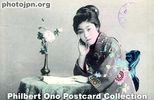
Flower in Vase. Nicely composed photograph. With a serene-looking face, she's an ideal postcard model. She also appears in the next postcard.Sep 19, 2008
|
|

Sep 19, 2008
|
|

Beauty with fan. The white space around her was for writing the correspondence. You could not write the message on the same side as the address. The back of the postcard was for the address only.So it has an undivided back, which means there is no dividing line between the address side and correspondence side, Postcards with an undivided back were made between 1900 and March 28, 1907. That's how we know the approximate age of this card even though it has no postmark.Sep 19, 2008
|
|

Girl at fence. Her posture is crooked, but somehow this photo looks nice. She's not sensationally attractive, but she's photogenic and comes across well. She also appears in the preceding postcard.Sep 19, 2008
|
|

Calligraphy on a folding fan.Sep 19, 2008
|
|

Swimsuit Beauties. These are typical swimsuits worn during the late 19th century. Horizontal stripes were in vogue. They are not posed very well, but there's something charming about them. This postcard is postmarked Aug. 1912. A nice summertime greetSep 19, 2008
|
|

Dancing womanSep 19, 2008
|
|

Cheek-to-Cheek. One of my favorite postcards. I wonder if they were sisters. Real-photo postcard with no divided back. The actual card is more yellowed, but I bleached it with Photoshop.Sep 19, 2008
|
|

Woman with pen and scroll. Judging from her hairstyle, this photo was probably taken during the Taisho Period (1912-1926).Sep 19, 2008
|
|

Poor posture and how not to pose in a kimono.Sep 19, 2008
|
|

Maiko on Gojobashi Bridge. Postcard-size real photo taken in Kyoto. She has been poorly posed. Her posture is bad, her kimono is ruffled, the sleeves look bad, and her feet are pointing in the wrong direction. Maiko usually know how to pose themselves.Postcard-size real photo taken in Kyoto. She has been poorly posed. Her posture is bad, her kimono is ruffled, the sleeves look bad, and her feet are pointing in the wrong direction. Maiko usually know how to pose themselves for a photograph. But not this one. Perhaps she's an amateur.Sep 19, 2008
|
|

Mona Lisa Smile. She's cute, ideal for a passport photo. But her hairstyle is more striking than anything. What do you call it? A Westernized Japanese hairstyle?Sep 19, 2008
|
|

Swimsuit pin-up. Another picture that makes you laugh. Apparently she felt sexy in that suit and knew how to pose like a pin-up swimsuit model.Sep 19, 2008
|
|
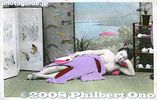
Nude woman lying downSep 19, 2008
|
|

After a bath. That's what it looks like. She was another very photogenic woman.Sep 19, 2008
|
|

Smiling for the camera. It's always nice to see a smiling woman on a vintage postard. This is not an ideal smile though. Kind of sheepish and unnatural. Sort of half-hearted and "halfway" like her fan which is only half open.Sep 19, 2008
|
|

Maiko with umbrella. The quickest way to tell if she is a geisha or maiko is by looking at her back. The tell-tale sign of a maiko is her long obi sash hanging down behind. Whereas the geisha's sash has a short knot instead.Sep 19, 2008
|
|

Laughing Maiko. Another card to cheer up the men at the front line.Sep 19, 2008
|
|

Girl with Umbrella. Hand-colored postcard dating before 1918. The kimono looks like casual wear, and the design pattern was typical during the turn of the 20th century. She's still in her teens it seems. One of the first vintage postcards I bought. Y2Sep 19, 2008
|
|

Girl in Storm. Wires were used inside the kimono to make it look wind-blown like in a rainstorm. Even her clogs are for rain. Early photographers commonly imitated the poses and scenes depicted in ukiyoe woodcut prints and Nihonga paintings.Although the photographer and model were serious in making this picture, it makes you laugh.Sep 19, 2008
|
|

Maiko hair ornaments. Maiko have more ornaments in their hair than geisha do. The hair ornaments differ depending on the current season. They usually have a flower motif, and if you look closely and see what flower it is, you can tell what season it is.Sep 19, 2008
|
|

Patriotic Maiko. Card designed to encourage soldiers on the front line. Notice that her sleeves are so long that you can see her right sleeve touch the ground. That's the kimono of a maiko. This is a modern postcard reproduction.Sep 19, 2008
|
|

The maiko uses her real hair, not a wig. When her hair is down, it reaches her chest.Sep 19, 2008
|
|

Smiling Maiko sitting in gardenNotice her left sleeve reaching the ground. A sign of a maiko's kimono, not a geisha's. Also, the high clogs that she wears are called pokkuri. Maiko wear them, but geisha do not.Sep 19, 2008
|
|

Oiran courtesan. Also see my photos of an oiran show here. My oiran video at YouTube here.The highest-ranking geisha is called an oiran or tayu. She is escorted by two little attendant girls called kamuro. Notice her high clogs. It takes some skill to walk in those and she usually requires someone's shoulder to hold onto while walking. Sometimes at festivals or special events, you can see the Oiran Dochu procession where she walks in a parade together with geisha attendants. Sep 19, 2008
|
|

Smiling Maiko Standing. Great smile. This is the same woman in the card where two maiko are holding the Japanese flag.Sep 19, 2008
|
|

Smiling Maiko Sitting. Real-photo postcard to cheer up soldiers. This card was sent as military mail from Kyoto on New Year's Day 1939. The kanji characters on the fan says "Banzai," the traditional Japanese cheer for victory and happy occasReal-photo postcard to cheer up soldiers. This card was sent as military mail from Kyoto on New Year's Day 1939. The kanji characters on the fan says "Banzai," the traditional Japanese cheer for victory and happy occasions. It also means "long life," something that soldiers would like.Sep 19, 2008
|
|

Two Patriotic Maiko. To cheer up the soldiers on the front line, pretty and smiling maiko (apprentice geisha) often appeared on postcards for military mail. This card was postmarked Aug. 1940 from Shizuoka city. It was not addressed to a soldier though.Both women are maiko and not full-fledged geisha yet. The sleeves of a maiko's kimono reaches toward the ground as you can see here. (The sleeves of a geisha is shorter.) The kimono design is also more colorful and gaudy. Maiko also wear clogs called pokkuri. They are wedged at the front, so if you are not careful, you can trip forward. Geisha do not wear pokkuri.Sep 19, 2008
|
|
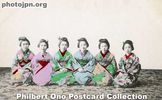
Brothel maids or prostitutes. Maids were employed to guide patrons to their rooms and serve sake and food. Or they could be low-class (cheap) prostitutes. Hand-colored, undivided back.Sep 19, 2008
|
|
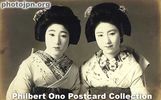
Pair of Geisha, autographed. One of my most treasured cards. This card was signed (on the chest area) by these two geisha with a fountain pen. Several other geisha also signed the back of the card. (See the next image.)Sep 19, 2008
|
|

Geisha Pair Outside Geisha House. These two geisha know how to pose for the camera. It looks like Kyoto. You can tell that they are geisha because of the shorter kimono sleeve, subdued kimono design (mostly black), and their clogs (for rainy weather).Sep 19, 2008
|
|
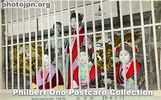
Shin-Yoshiwara prostitutes. They are sitting behind the "cage" which fronted the street for all to see (and choose) within the licensed quarters. Shin-Yoshiwara was a famous red-light district of Tokyo. Note that they are not geisha.Geisha were not prostitutes. This photo was taken during 1907-1911. The woman in the far back was the brothel's matron who supervised this live display and everything else. In 1912 when Emperor Meiji died, this live display of women was later replaced by framed photographs of each woman hung near the brothel's entrance. In 1958, prostitution was outlawed in Japan, and Yoshiwara was history. Sep 19, 2008
|
|
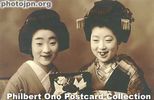
Geisha and maikoNot a good photo, but their names are written in hiragana on the back. They read "Suimatsu" on the left and "Shigezuru" on the right who is a maiko, not geisha. She has more ornaments in her hair than the geisha. Also notice their blackened teeth. If they are in Kyoto, a geisha is called "geiko." In Tokyo, a maiko (apprentice geisha) is called "hangyoku." This is a postcard-size photo and not a postcard.Sep 19, 2008
|
|

Laughing Geisha with Basket. It looks like she's dressed for picking tea leaves. This card, which has an undivided back, dates before 1907. The actual card is more yellowed.Sep 19, 2008
|
|
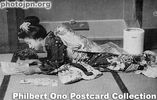
Maiko in Her RoomA private moment. This maiko is lying down in her kimono reading a comic book after getting tired of playing cards. Her mama-san probably would not be pleased to see her wrinkle the kimono like that. Not sure if this was staged or a candid shot. It's hard for anyone to lie down like that in a kimono.Sep 19, 2008
|
|
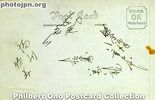
Pair of Geisha, autographed (back). This is the back of the preceding card. It looks like four geisha signed it.Sep 19, 2008
|
|
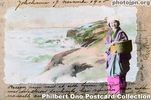
Laughing Geisha on Shore. It's kind of strange to see her at the beach but dressed to pick tea leaves. The message on this postcard was written in French, dated 1905.Sep 19, 2008
|
|

Laughing Geisha with baby. She's nicely posed, and you can even see the baby's face. But the color of her kimono is somewhat drab. A mother (or married woman) does not and need not wear a colorful kimono.Sep 19, 2008
|
|

Another shot of her picking tea leaves.Sep 19, 2008
|
|

Drawing water from a well.Sep 19, 2008
|
|

Laughing Geisha in the rain. There's a horse in the background. Maybe she's watching a parade. The ground looks wet.Sep 19, 2008
|
|

Laughing Geisha with umbrella. As you may have noticed, the umbrella (and fan) was a commonly used prop in tourist photos. Postmarked 1903 from Yokohama. The actual card is more yellowed and almost brown, but I bleached it with Photoshop.Sep 19, 2008
|
|

Sep 19, 2008
|
|

Laughing Geisha with umbrella. The sender probably wrote about his incredible adventures in Japan. Postmarked 1904 from Yokohama addressed to Hamburg, Germany. The actual card is more yellowed and almost brown, but I bleached it with Photoshop.Sep 19, 2008
|
|

Laughing Geisha looking out. The card is postmarked 1903 from Yokohama. The actual card is more yellowed and almost brown, but I bleached it with Photoshop.Sep 19, 2008
|
|

Laughing Geisha on terrace. It looks like she's on the veranda of a restaurant along a river. If she's a Kyoto geisha, it would be the Kamo River. But these cards were made in Yokohama. I wonder if she was from Yokohama.Sep 19, 2008
|
|

Laughing Geisha with low neck. She's almost semi-nude. It is probably her sexiest pose of all. A great summertime card and one of my favorites. Hand-colored and postmarked Feb. 25, 1908 in Yokohama. The actual card is more yellowed.Sep 19, 2008
|
|

Laughing Geisha with fan. There are two Yokohama postmarks on this card. One in Japanese (over the stamp) and one in English. The actual card is more yellowed and almost brown, but I bleached it with Photoshop.There are two Yokohama postmarks on this card. One in Japanese (over the stamp) and one in English. Japanese postmarks have the date in the Year-month-day format. And English postmarks have it in the Day-month-Western year format. As you may know, Japan bases its years on the Emperor's reign. In the Japanese postmark, you can see "36" for the year. That's not 1936, but Meiji 36 that corresponds to 1903. Besides the Meiji Period (1868-1912), there's the Taisho Period (1912-1926) and the Showa Period (1926-1989). Since the Japanese postmark only indicates the last two digits of the year, it can be a pain to figure out which period the year belongs to. In most cases, we can figure it out with the stamp or type of postcard back.Sep 19, 2008
|
|
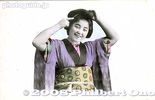
Combing her hair.Sep 19, 2008
|
|
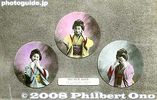
See, hear, nor speak no evil.Sep 19, 2008
|
|
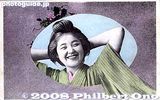
Out of all the geisha that have appeared on postcards, this ever-smiling geisha was unsurpassed in popularity. Her smiling visage appeared in 40 to 50 different poses in photographs and postcards made in Yokohama from the 1890s.Sep 19, 2008
|
|

Laughing Geisha with cowboy hat & cigar. This must be the most humorous pose she created. Those tourists must've gotten a big kick when they saw this card. A geisha from the wild, wild West. Even today, it elicits an affectionate laugh. One of mySep 19, 2008
|
|
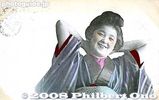
A saucy little Geisha. The pose is good.Sep 19, 2008
|
|
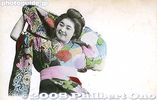
Her name has been a mystery, but I have come across hard evidence that she was a geisha named "Tokimatsu." But I will forever call her the "Laughing Geisha."Sep 19, 2008
|
|

Her affable and infectious smile made her stand out during a time when most people posing for a photograph did not smile.Sep 19, 2008
|
|
|
|